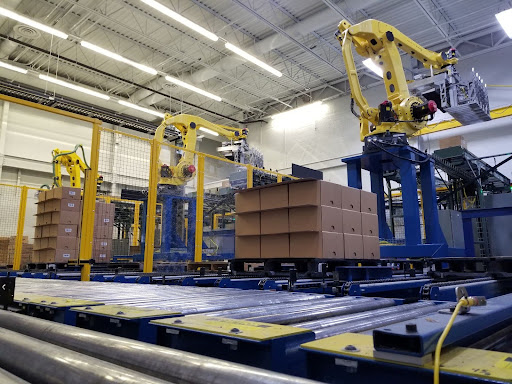Collaborative vs. Industrial Palletizing Robots: When to Choose Speed Over Flexibility
When you’re evaluating palletizing automation, the first decision isn’t whether to automate—it’s which robot architecture fits your production reality. Collaborative robots promise flexibility and easy deployment, but industrial palletizers deliver the speed and payload capacity that keep high-volume lines running. The wrong choice means either overspending on capability you don’t need or underperforming against your throughput targets.
As an authorized Fanuc robotic integrator, Remtec helps manufacturing operations match robot capability to actual line requirements—not vendor marketing claims.
Key Decision Factors:
- Payload capacity: Cobots typically max out at 25 kg; industrial palletizers handle 300+ kg (don’t forget tooling weights)
- Cycle time: Industrial robots deliver 10-20 cycles/minute vs. 3-6 for cobots
- Footprint: Cobots require minimal guarding; industrial cells need dedicated floor space
- Integration complexity: Cobot deployment in days/weeks; industrial systems require full engineering
When Does a Collaborative Robot Make Sense for Palletizing?
 Cobots work when your operation prioritizes flexibility over raw throughput. If you’re running multiple SKUs with frequent changeovers, lower case weights (under 15 kg), and cycle times that don’t demand sustained high-speed operation, a collaborative palletizer can eliminate the overhead of traditional safety guarding while maintaining acceptable output.
Cobots work when your operation prioritizes flexibility over raw throughput. If you’re running multiple SKUs with frequent changeovers, lower case weights (under 15 kg), and cycle times that don’t demand sustained high-speed operation, a collaborative palletizer can eliminate the overhead of traditional safety guarding while maintaining acceptable output.
The real advantage isn’t the collaborative feature itself—it’s deployment speed and reconfigurability. You can relocate a cobot palletizer between lines without major facility work or rewiring existing conveyors.
Cobot palletizing fits when:
- Production volume is under 8 cases per minute consistently
- You need to redeploy the system across multiple lines seasonally
- Your facility can’t accommodate traditional safety fencing
But be honest about sustained throughput requirements. A cobot running at capacity with no headroom becomes a bottleneck the moment production targets increase.
What Makes Industrial Palletizing Robots the Better Long-Term Investment?
 Industrial palletizers handle the sustained cycle rates and heavy payloads that define high-volume production. If you’re moving cases over 20 kg, stacking full layers at 10+ cycles per minute, or palletizing around the clock with minimal intervention, an industrial robot isn’t overkill—it’s the only architecture that maintains uptime without degrading performance.
Industrial palletizers handle the sustained cycle rates and heavy payloads that define high-volume production. If you’re moving cases over 20 kg, stacking full layers at 10+ cycles per minute, or palletizing around the clock with minimal intervention, an industrial robot isn’t overkill—it’s the only architecture that maintains uptime without degrading performance.
Remtec, as an authorized Fanuc robotic integrator, designs industrial palletizing cells that integrate with your existing conveyor systems, WMS data, and quality inspection stations. The upfront engineering investment pays back in throughput consistency and reduced maintenance cycles.
Industrial robots deliver when:
- Case weights or grouped picks exceed 25 kg regularly
- You’re stacking mixed SKU pallets requiring complex pattern generation
- Product includes open top trays or display cases which require non-collaborative grippers
- Line speeds demand 12+ cycles per minute sustained performance
- Integration with upstream production (conveyor timing, reject handling) is critical
The maintenance profile differs too. It is important to consult your integrator and robot manufacturer on the appropriate preventative maintenance plans based on the robot selection and annual usage.
How Do You Decide Without Overcomplicating the Evaluation?
Start with your actual production data, not projected capacity. Pull cycle time logs for each production line, case weights & size data, pallet patterns, packaging types, and changeover frequency from the last 90 days (up to to 1 year). If your median cycle requirement sits below 6 cases/minute with the right pallet patterns and payload stays under 15 kg, a cobot likely fits. If you’re pushing 10+ cycles with heavier loads or need to scale throughput within 18 months, specify industrial from the start.
Don’t retrofit later. The installation cost difference between deploying the right system initially versus upgrading 12 months in, erases any savings from starting with undersized equipment.
As an authorized Fanuc robotic integrator, Remtec delivers system sizing based on real throughput analysis, not generic capability charts. We scope both collaborative and industrial options with specific performance modeling tied to your SKU mix and line constraints.
Technical Specifications
Collaborative Palletizers (Typical Range):
- Payload: 10-25 kg
- Reach: 1,300-1,800 mm
- Cycle time: up to 6 cases/minute
- Safety: RIA 15.06-2025 with additional ISO 10218 force/speed limiting/monitoring considerations
Industrial Palletizers (Fanuc M-410 Series Example):
- Payload: 140-700 kg
- Reach: 2,400-3,100 mm
- Cycle time: up to 25+ cases/minute sustained
- Integration: Full end-of-arm tooling compatibility, conveyor synchronization
- Safety: RIA 15.06-2025 and ISO 10218
FAQ
Q: Can we start with a cobot and upgrade to industrial later without scrapping the investment?
A: Not practically. The infrastructure differs—power requirements, conveyor integration points, control architecture. You’ll keep the end-of-arm tooling, but the cell itself doesn’t migrate. Size correctly from the start based on 24-month production projections.
Q: How much downtime should we expect during installation for either system type?
A: Cobot installations often occur during normal maintenance windows with 1-2 day interruptions. Industrial cells require coordinated shutdowns—typically 2-7 days for mechanical installation, another 2 days for integration testing and operator training. Remtec phases commissioning on multi-robot systems to minimize line impact.
Q: Do our operators need different training for collaborative vs. industrial systems?
A: Yes. Cobot systems allow hands-on teaching and adjustment with specific safety restrictions. Industrial palletizers require lockout/tagout procedures and formal safety certification. Budget 8-12 hours per operator for industrial systems; 1-4 hours for cobots.
Q: What happens when the robot fails mid-shift—can we bypass and palletize manually?
A: Robots are typically the most robust element of a palletizing system. Other components are usually the cause of downtime. If a cell must be bypassed, industrial systems should include bypass conveyor paths designed into the layout. Cobots often operate inline, manual workarounds are typically handled upstream. Specify redundancy requirements during scoping—Remtec engineers contingency handling based on your downtime tolerance.
Ready to Size Your Palletizing Solution Correctly?
You’ve already identified the bottleneck. The next step isn’t vendor calls—it’s defining your actual throughput envelope and integration constraints so you spec the right architecture from the start.
Remtec provides facility-specific palletizing assessments with performance modeling based on your production data. As an authorized Fanuc robotic integrator, we engineer both collaborative and industrial solutions—and we’ll tell you which one actually fits your operation.
Schedule a technical consultation: Share your cycle time data and case specifications. We’ll model both approaches with specific ROI timelines and integration requirements.


